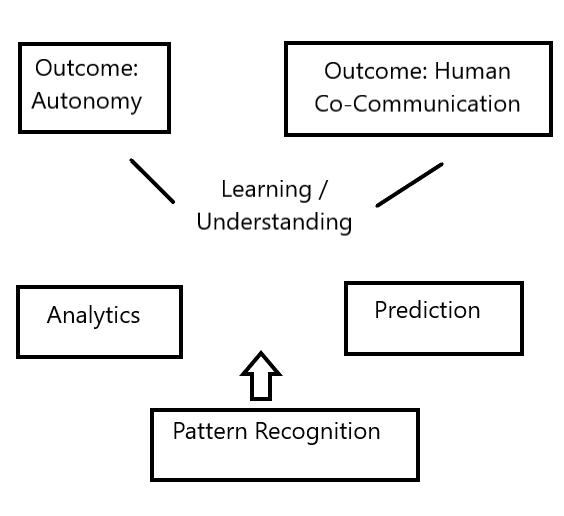The front page of bolsterco.com has a definition of Artificial Intelligence (AI). Interesting to see how people change the way the term AI is applied over time, as things change. The best way to illustrate this is to consider that most people don’t think they’re “using AI” when searching for information on the web or using Google Maps. Those services both do use lots of AI. If you showed the current incarnation of Google Search and Maps to a computer scientist in 1995, they would be screaming “It’s AI! AI I tell you!”
There are many overly complicated definitions of what AI is and does. Too clarify up front, Machine Learning is the main way to achieve what people consider AI today. I’ll discuss the general importance of Learning here, among other things. That is part of breaking down a simplified understanding of AI. This diagram is for the simplification:

Outcomes – Autonomy and Human Co-communication
Taking it from the top first to discuss Outcomes. Why are we using AI? Many of the overall highest-level outcomes that we talk about getting out of AI boil down to Autonomy and Co-Communication (between computers and people). Autonomy in AI means the system can operate and make decisions on its own. While safety is a strong consideration with Autonomy, understand that many of our uses of AI today safely make autonomous decisions. In our example, a Google search partially uses AI in the system to hunt and deliver relevant information for you – not a person behind the curtain. That is an example of Autonomy. Co-Communication between people and machines is not the only other high-level output of AI, but it is a very important one. We exchange information today with systems by text, voice, images, video and even Virtual Reality. Natural Language Processing (NLP) and Natural Language Understanding (NLU) are examples. Accuracy in that Co-communication and new ways to communicate are improving rapidly.
Pattern Recognition
Now going straight to the bottom, the core computer capability that starts creating theses AI outcomes is statistical Pattern Recognition. It really starts with Math. AI IS Math for the most part. AI needs a pattern to grab on to and pattern recognition creates the comparisons for grabbing on. An example lies in Vision, where there has been much AI progress and excitement over the last 10 years. When a Machine Learning Model needs to detect a cat’s face, it first looks for edges in the photo. An edge is easy to spot because there is a contrasting pattern with an edge. The cat’s ear might be dark, for instance and the background behind it might be light. That is an edge. The edge is how it begins to recognize the ear then the cat (or a number or a letter – simplified). Ideas found in text or video have edges that computers can grab onto as well. The idea of an AI computer winning in a video game has more than played out in labs and on our phone apps. The AI in a game is not fighting the guy with a gun, it’s fighting the pixels and math that make up that guy.
Analytics and Prediction (Predictive Analytics)
Past and Future
Much AI doesn’t even get to the level of Autonomy and Co-Communication. In fact, much of what companies call AI today is really either Analytics or Prediction. This is fine, whether it’s true AI or not goes back to that discussion about the definition of AI moving over time. Analytics and Prediction probably would have been called AI a few years ago. Typically, they both use a lot of data (Big Data, in fact). Analytics tells you what happened in the past and Prediction, well, tells you the future. Using Pattern Recognition to find trends in data, like sales over time or the location of your best customers, companies can judge the past. Similar techniques can use that history to make decisions about the future. Most importantly, Artificial Intelligence services or capabilities are often built on top of Analytics and Prediction programing.
Learning / Understanding is crucial
In order to get the Outcomes displayed in the diagram without someone programing every step, every word, every decision the machine makes – you need Learning and Understanding. Learning through machine learning (ML) and deep learning (DL uses human-like neurons) is a good indicator that a technology is actually AI today vs. just computer programing. It is crucial and the goal of Learning is Understanding. But can machines really understand today? They can in a mathematical, pattern recognition sense. It will be years before they have enough sensory inputs, memory and mental models to really have context. Although they can tell you which one is a cat today, they don’t know what a cat really is. Does that mean AI cannot be useful? Absolutely NOT! AI in Business has already paid huge dividends for companies willing to try. For instance, AI for Sales has increased efficiencies all over the world and uncovered huge opportunities, even in these early days.
